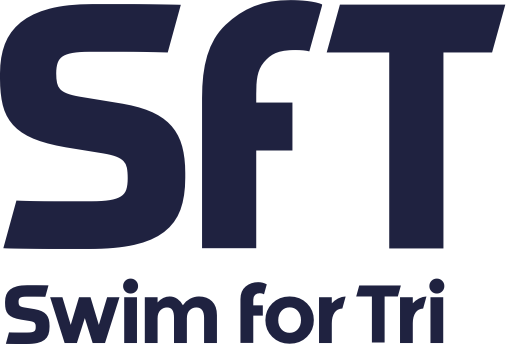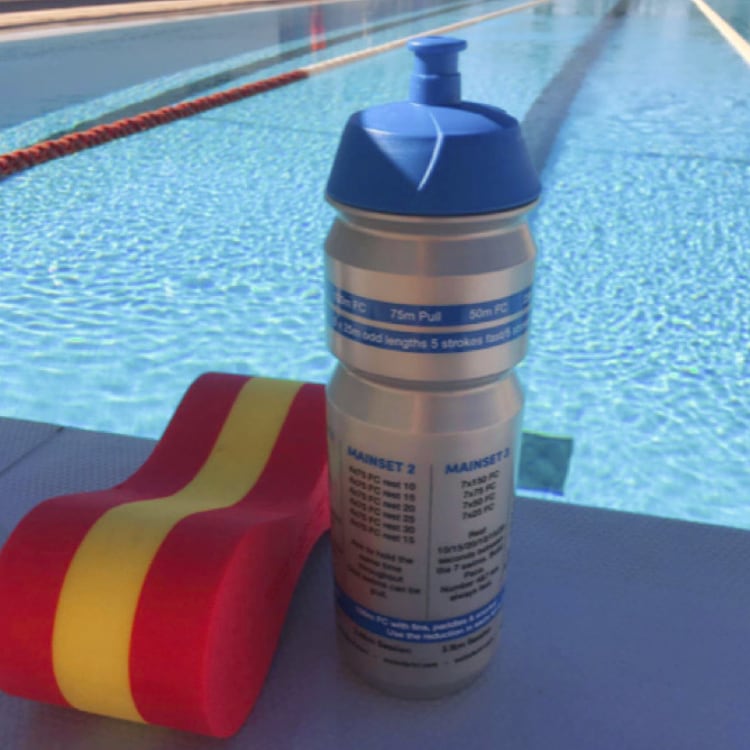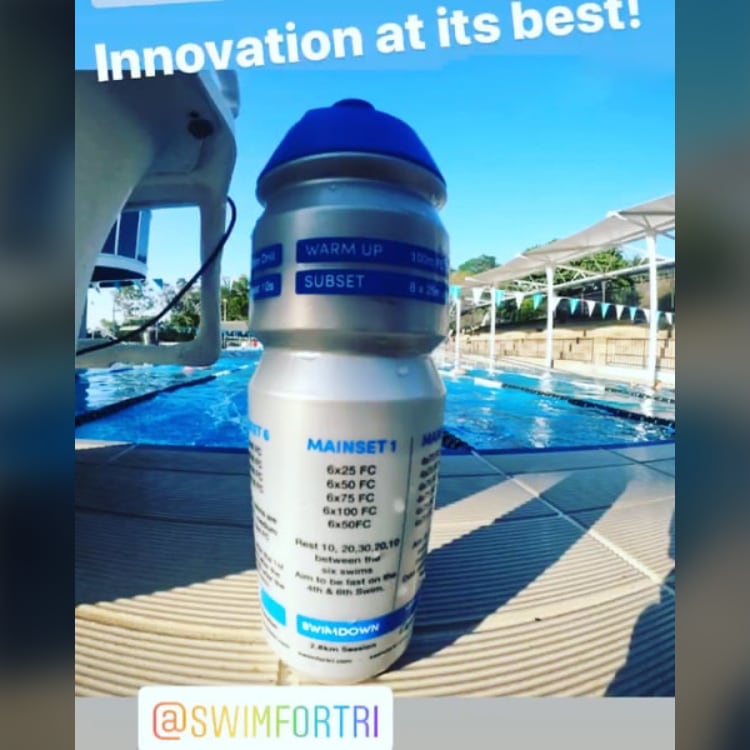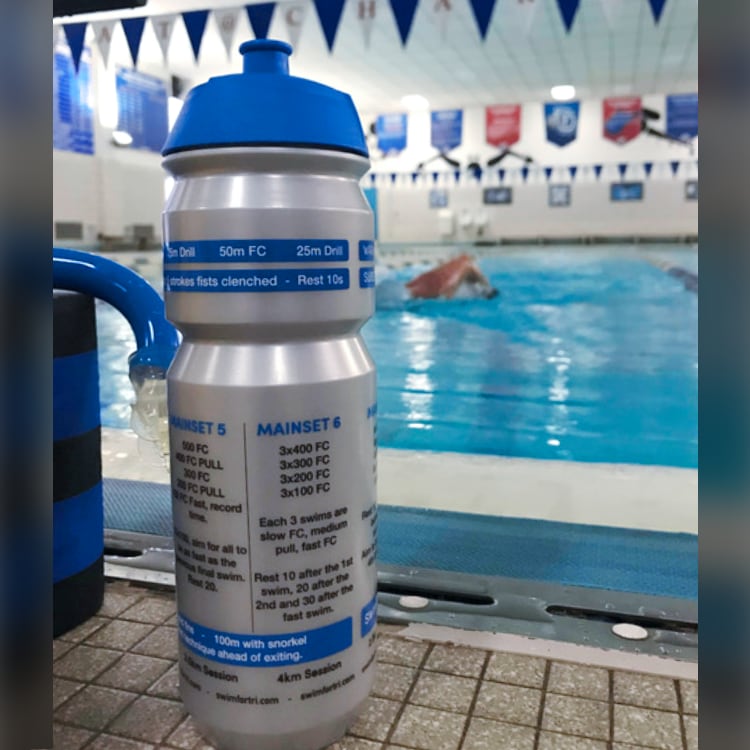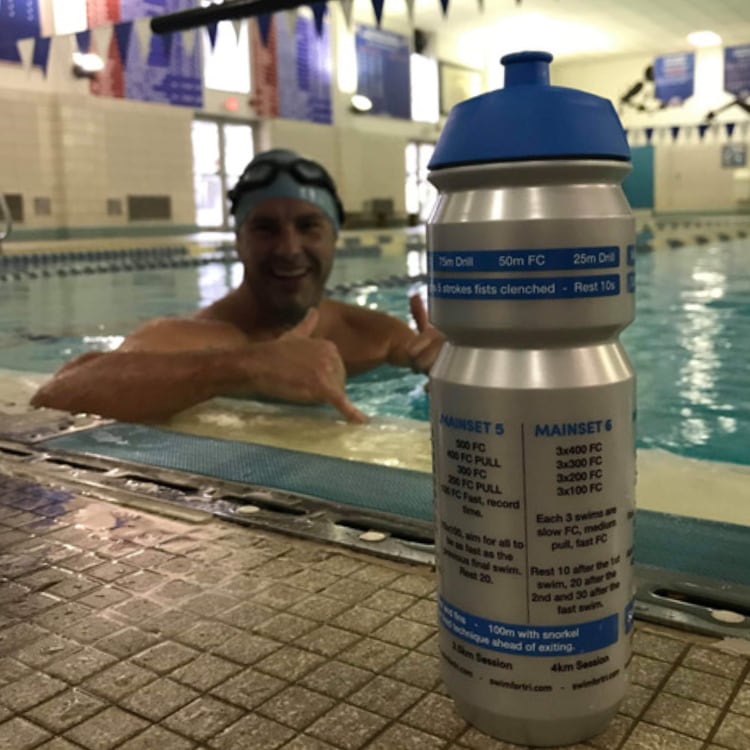Session in a Bottle
By Swim for Tri
How to get more from your session in a bottle
With a few tweaks to the rest periods and formats you can get so much more from your session. As an example-
ENDURANCE 1 session from the new Black Eco Bottle
Swim 100m /200m/400m/800m FC & with each aim to be quicker than x2 the previous swim.
Rest 30 throughout.
Continue with 400m/200/100m FC aiming to be quicker than half the previous swim.
(2200m)
Mini Version
Swim 50m /100m/200m/400m FC & with each aim to be quicker than x2 the previous swim.
Rest 30 throughout.
Continue with 200m/100/50m FC aiming to be quicker than half the previous swim. Now only 1100m but still a challenge.
A simple challenge that will require some clock watching and counting! Most swimmers in our fitness groups found this particularly challenging but that depends a lot on how you start out. Start steady to keep it manageable. Try again in 6-8weeks and be a little more adventurous in how hard you start and how far you get before challenge gets too much.
PURPOSE – A simple way to create and sustain some motivation to keep swimming faster. Each swim creates the next challenge so you should stay motivated and challenged without the need for teammates or a coach on poolside shouting encouragement.
HOW TO GET THE BEST FROM IT – Keeping a check on the clock is vital, not only for recording times but also being accurate with length counting. If either of these are missing, then the session will lose its value. Start steady else the targets will soon become ‘impossible.’ Add fins or a pull buoy later if you need help beating times having started too fast.
When we say aim to swim ‘faster than’ it just needs to be 1sec, not huge chunks of time. Good Pacing is the repetition of good swim technique coupled with fitness. As a long swim goes on you do not need to get faster just avoid getting any slower to finish well.
Another Challenge/interpretation.
100 FC record time, rest 30secs throughout.
200 FC aim to be quicker than double the 100m FC time previously swum.
400 FC aim to be quicker than double the 200m FC.
200 FC aim to be quicker than half the 400m FC.
100 FC aim to be quicker than half the 200m FC.
8x50 FC each of which aim to be quicker than half the last 100m FC.
1400 mainset
Silver Bottle Session
Other variations – Flip the session and start with 5x100 with 30 keeping them steady and technical and build to 1x with 10 in the middle fast. Or leave the rest as it should be for a more Openwater specific hard start to your race ie 5x100 with 10 and then ease into the mid race cruise with more rest at the 1x100 with 30. Pick up the pace again as the rest decreases towards 5x100 with 30 again. This could be of use depending where your season is at. For a shorter swim session skip the 5x and peak at 4x in the middle for a smaller 1600m mainset more useful for racing standard/middle distance.
Once familiar with the many variations this is the final really hard variation. Start steady and build to a fast 5x100 block in the middle and then you could attempt to get faster still as the rest goes up and repeats go down.
1x100 with 30 (or try an interval - 2mins? Your choice but you want approx. 30s rest)
2x100 with 25 (1:55)
3x100 with 20 (1:50)
4x100 with 15 (1:45)
5x100 with 10 or 1:40
4x100 with 15 (1:45)
3x100 with 20 (1:50)
2x100 with 25 (1:55)
1x100 with 30 (2mins)
KEY POINTS TO GET THE BEST FROM YOUR SESSIONS:
1 Try to arrive poolside as rested as possible given that you are squeezing 3 sports into one week I appreciate that is not easy. Tired legs from biking and running will possibly have you reach for a pull buoy and continue to perform a less than optimal session. You will also possibly cramp quicker and again ruin your session. Good hydration and nutrition will help and you will sweat while you swim so keep drinking. A lower limb dynamic stretch routine will help the body start to become a little more accepting of the unaccustomed swim positions that we are asking while swimming.
2 Make use of swim equipment to maximise and accelerate swim improvements. The sessions will include frequent use of swim accessories and if you are allowed to use them you should. Fins and Central snorkels seem to be the main offender that pool operators do not like. Depending on how seriously you are taking your sport then I have heard of people changing pools to enable equipment use. At the least be sure to speak to at least a Duty Manager and explain your wishes, at quiet times they might be a little more accommodating.
3 Give swim improvements time, quite a lot of time. Swimming is more like learning a language or a musical instrument. Timing, coordination, ungainly new movements in the alien environment of water along with restricted breathing makes this a huge undertaking. Given how completely wrong some movements can be performed though early improvements can be dramatic as even small changes away from paddling water in the wrong direction to now channeling it in the correct direction will yield great improvements. The slower you are the more you can improve with frequent swimming. The better you are as with most things the gains become harder to achieve but to me are worthwhile even when swimming will take up a small proportion of your race.
4 A Pull buoy should be a part of your swim training and you will find them used throughout these sessions. It should not be a continually relied upon aspect of your swim technique. If you can pull faster then you can swim then you should have a coach take a look at your leg kick and work out what is holding you back. Usually a combination of toes pointed to the bottom of the pool from tight ankles/shins or pivoting at the knee on both an upsweep and down sweep rather than from the hip on the upsweep.
5 Easier pure drills sessions can be considered an ideal lower Heart Rate zone training session. Initially swimming full stroke FC may well be so inefficient that it will be quite exhausting. Many Triathletes tell me that they cannot swim slowly enough to get into their lowest ‘Z1’ HR zone as set by their Triathlon coaches. Many of the simple body position drills performed with fins and a central snorkel could be considered an easy ‘Active Recovery’ style of session and should keep the HR lower.
6 Add dry land movements from the worlds of Pilates and Yoga if your mobility, coordination or body awareness is poor. Many sports need a solid upper body moving in one direction. A good swimming body position needs for the head to be kept still yet the upper body to rotate from side to side through its long axis. Try this standing in front of a mirror allowing the hips to follow the movements of the upper body. It is not easy. Likewise if you cannot point your toes away from the body a pure streamlined body position is not going to be easy to achieve which will keep the legs sinking.
7 The arms and legs should not be relied upon to work as stabilizers propping up a poorly positioned body alignment or by splaying outwards preventing you from rolling onto your back. One of the key technical issues I see daily is that of people pushing down with a straight arm, palm of the hand facing the bottom of the pool to help elevate the head for a breath. Each breathing stroke then becomes inefficient. Worst cases often need a large splayed leg kick to counter balance the wide straight arm sweeps creating more drag. There is a good reason that even Olympians still perform simple drills such as sidekick with lower arm outstretched (think Superman or I prefer ‘Extension’ position.) When the body is balanced and the arms and legs are no longer needed as stablisers then they can be used far more effectively for propulsion.
8 Often in Triathlon swimming we get the location of a simple pivot point in the wrong place. Straight arms when submerged and bent legs are a major hindrance. The best-streamlined position comes from a straighter leg but keep in mind it is fine to bend at the knee on the down sweep but not the upsweep. Similarly we are looking for a wide elbow pivoted to expose the forearm and palm of the hand to be facing the wall you are swimming away from. If you pivot at the wrist or at the shoulder then you will not have both surface areas in the correct position. Faster swimming needs good streamline and the arms channeling the water in the correct direction for best movements forwards. Look at the technology and design in the forearm panel of your wetsuit if you need convincing.
9 Work to reduce a high stroke count, high being anything above 1stroke per metre traveled but don’t chase an unrealistic low score that involves excess kicking and gliding. Make use of an optimal amount and use that as an alarm bell warning you of your stroke deteriorating during longer fitness blocks of work if the stroke count goes much above its normal range. Many of the new SWIM WATCHES offer a measure of efficiency by combining stroke count and time. These two factors when added together can be of great use and you do not need a watch to help. Just add the time taken to swim 25m to the number of strokes taken. If this total score comes down through better overall efficiency and fitness then, faster swimming is inevitable. Push too hard with a frantic stroke and while the time might come down, the stroke count will rise. Glide too much to lower the stroke count and the swim time will go up keeping the overall score high. Record this on a regular basis to gauge improvements to efficiency.
10 Aim to attend a realistic monthly-deemed number of sessions rather then a weekly amount. I ask for and recommend 14 per month if someone wants to really make some progress. An aim of 4 per week may well be an admirable aim which occasionally may be reached but too often I see that rewarded with 2 the following week which is not really enough if as mentioned you want to override old habits, instill better technique and improve fitness. Three sessions per week allows a Techncial Endurance drills session to be swum which could be treated as a recovery session, an OW skills (in the pool) and finally two solid fitness blocks of work either in the pool or OW. Every other week I might suggest a swim test, which are included to round up to 14 sessions per month. You can add these sessions to your regular weekly routine for some variety as they will stand-alone or create a small training plan to fine tune the final few months ahead of a key race.
